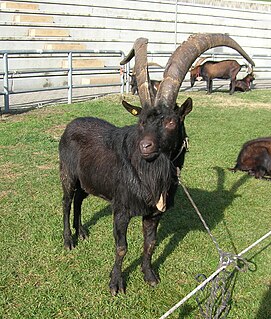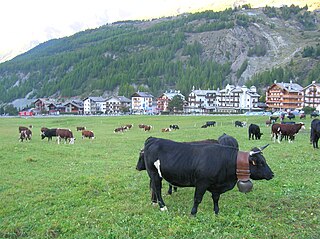
The Chianina is an Italian breed of cattle, formerly principally a draught breed, now raised mainly for beef. It is the largest and one of the oldest cattle breeds in the world. The famous bistecca alla fiorentina is produced from its meat.

The Piedmontese is a breed of domestic cattle that originated in the region of Piedmont, in north-west Italy. The calves are born fawn coloured, and turn grey-white as they mature. Piedmontese cattle carry a unique gene mutation identified as an inactive myostatin allele that causes hypertrophic muscle growth, or double muscling. Purebred Piedmontese cattle are homozygous, meaning they have two identical alleles present for this unique gene. They have garnered attention from breeders of beef cattle in other parts of the world, including North and South America. A small group of select Piedmontese bulls and cows were imported into Canada in the late 1970s, and into the United States in the early 1980s, and were used as the foundation breeding stock to develop a new breed of beef cattle known as North American Piedmontese cattle.
The Agerolese is a breed of dairy cattle from the area of Agerola, in Campania in southern Italy. It is particularly associated with the Sorrento Peninsula and Monti Lattari. It derives from cross-breeding of indigenous Podolica cattle with Italian Holstein-Friesian, Bruna Italiana and Jersey cattle. It is one of the sixteen minor Italian cattle breeds of limited diffusion recognised and protected by the Ministero delle Politiche Agricole Alimentari e Forestali, the Italian ministry of agriculture.
The Burlina is a breed of cattle from the mountainous areas of the Veneto region of north-east Italy. It is distributed mainly in the provinces of Treviso, Verona and Vicenza. It is a dual-purpose breed, but is raised principally for milk production. It has been suggested that it may be related to the similar Bretonne Pie Noir breed of small pied dairy cattle in Brittany.

The Comisana, also known as Faccia Rossa and Lentinese, is an Italian breed of domestic sheep indigenous to central and northern areas of the Mediterranean island of Sicily. Its name derives from that of the comune of Comiso, in the province of Ragusa. It is raised principally in the provinces of Caltanissetta, Enna and Palermo, but is found in many other Italian provinces and has also been exported to other Mediterranean countries.

The Podolica is a breed of domestic cattle from southern Italy. It belongs to the Podolic group of grey cattle. It is raised in the regions of Abruzzo, Basilicata, Calabria, Campania, Molise and Puglia. It was formerly distributed throughout most of mainland Italy and as far as Istria, now part of Croatia, and where it is now regarded as a separate breed, Istrian cattle. The Podolica was in the past bred principally as a draught animal; with the mechanisation of agriculture following the Second World War demand for draught oxen disappeared, and the Podolica is now raised for meat and, to a lesser extent, for milk.
The Pezzata Rossa d'Oropa is a cattle breed from the provinces of Vercelli and Biella in the Piedmont region of Italy. It is one of the 16 minor Italian cattle breeds of limited diffusion recognised and protected by the Ministero delle Politiche Agricole Alimentari e Forestali, the Italian ministry of agriculture.
The Brentegana is an Italian breed of sheep from the provinces of Trento and Verona in northern Italy. The name derives from that of the comune of Brentonico, the area where the breed is thought to have originated. Two distinct types are known: the Brentegana Scelta or Brentegana Trentina, a large heavy meat/wool type; and the Brentegana Comune, a medium-sized type more suitable for milk production. It is one of the forty-two autochthonous local sheep breeds of limited distribution for which a herdbook is kept by the Associazione Nazionale della Pastorizia, the Italian national association of sheep-breeders.
The Frabosana is a breed of sheep from the valleys of the Monregalese, the area around Mondovì in the province of Cuneo, in Piemonte in north-west Italy. It takes its name from the comuni of Frabosa Soprana and Frabosa Sottana, and was once the most numerous sheep breed of Piemonte. It is raised in the Valle Gesso, the Valle Grana, the Valle Pesio, the Valle Vermenagna and the Valli Monregalesi in the province of Cuneo, and in the Val Pellice in the province of Turin. Two types are recognised within the breed, the Roaschino in the Ligurian Alps, and the slightly smaller Frabosana raised in the area of Mondovì. The Frabosana is one of the forty-two autochthonous local sheep breeds of limited distribution for which a herdbook is kept by the Associazione Nazionale della Pastorizia, the Italian national association of sheep-breeders.
The Istriana or Carsolina, Croatian: 'Istarska Ovca', Slovene: 'Istrska Pramenka', is a breed of domestic sheep from Istria and the Karst regions of the northern Adriatic, from north-east Italy to Croatia and Slovenia.
The Sopravissana is a breed of domestic sheep from the province of Macerata, in the Marche in central Italy. The name derives from the area of origin, the comune of Visso in the Monti Sibillini; it was traditionally raised mostly in that area, but flocks ranged into Lazio, Tuscany and Umbria. The Sopravissana derives from the cross-breeding of local ewes with Spanish and Rambouillet Merino rams in the 18th century. It is larger than the Vissana breed from the same area.

The Rendena is a breed of cattle from the Trentino, in north-eastern Italy, now raised principally in the provinces of Padova, Trento, Verona and Vicenza. It is particularly suited to transhumant management; almost all the stock in the Trentino spends the summer months on the mountain pastures of the Val Rendena, and more than half of that in the Veneto summers on the Altopiano di Asiago.
The Nera di Arbus, more fully Pecora Nera di Arbus, is a breed of small domestic sheep indigenous to the Mediterranean island of Sardinia, Italy. It takes its name from the comune of Arbus, in the province of Medio Campidano, in the south-western part of the island. It is raised in the provinces of Cagliari, Nuoro, Oristano and Sassari. The breed achieved official recognition in 2008.
The Delle Langhe, also called Pecora delle Langhe or Langarola, is a breed of domestic sheep indigenous to Piedmont, in north-western Italy. It is a rough-woolled breed of southern Mediterranean type, and originates from the mountainous area of the Alta Langa, where the Apennines meet the Alps, in the province of Cuneo. It is raised mainly in the Langhe, but is found in several other regions of Italy including Abruzzo, Basilicata, Emilia–Romagna, Liguria and Tuscany.

The Valdostana is an indigenous breed of domestic goat from the autonomous region of Aosta Valley in north-western Italy, from which it takes its name.
The Cilentana Fulva is an indigenous breed of domestic goat from the province of Salerno, in Campania in southern Italy. It takes its name from the geographical region of the Cilento, much of which is today within the Parco Nazionale del Cilento, Vallo di Diano e Alburni, and is raised in that area, in the Monti Picentini, and throughout the province of Salerno. It is one of three indigenous goat breeds in the Cilento, the others being the Cilentana Grigia and the Cilentana Nera. The Cilentana Fulva is found on lower ground and richer pasture than the Cilentana Nera, and is raised mainly for milk. It appears to derive from inter-breeding of local goats with the Maltese and particularly the Derivata di Siria, with which it shares many characteristics.

The Valdostana Castana is an Italian breed of cattle from Valle d'Aosta region in north-western Italy. It is one of three regional breeds in the area, the others being the Valdostana Pezzata Nera and the Valdostana Pezzata Rossa. The Valdostana Castana ranges in colour from chestnut-brown to black. It derives from cross-breeding of imported Hérens stock with the local Pezzata Nera (black-pied) cattle. While the Valdostana Castana is raised both for meat and for milk, its principal characteristic is its ability in the Bataille de Reines, the annual cow-fighting contests held in the region. Partly due to its combative nature, it is not suited to intensive farming, and management is normally transhumant: the cattle are stabled only in winter, and spend the summer months on the mountain pastures of the Alps.

The Valdostana Pezzata Nera is an Italian breed of cattle from Valle d'Aosta region in north-western Italy. It is black-pied, with short horns. It is one of three regional breeds in the area, the others being the Valdostana Castana and the Valdostana Pezzata Rossa. Like them, it derives from inter-breeding of various local breeds and types of cattle. It appears to have been most influenced by the Swiss Fribourgeoise and Hérens breeds, which came into the Valle d'Aosta over the Great St. Bernard Pass. The Valdostana Pezzata Nera is a dual-purpose breed, raised mainly for milk, but also for meat. Management is normally transhumant: the cattle are stabled only in winter, and spend the summer months on the mountain pastures of the Alps.









